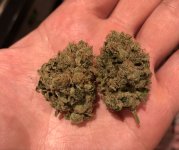goingrey
Well-known member
The LED and bud quality thread is a different one.
This one is about the benefits and disadvantages of these three commonly used lighting technologies. Which is a worthwhile discussion IMO. If you disagree, that's fine, but the thread title seems clear enough.
That said, claiming LED bud is better than ever is admitting that there is a difference. Understanding the differences would let the grower make a more informed decision on which light to use in which situation.
The horse ain't dead yet. You guys touting the same opinion over and over again are beating a live horse, sick fucks.

This one is about the benefits and disadvantages of these three commonly used lighting technologies. Which is a worthwhile discussion IMO. If you disagree, that's fine, but the thread title seems clear enough.
That said, claiming LED bud is better than ever is admitting that there is a difference. Understanding the differences would let the grower make a more informed decision on which light to use in which situation.
The horse ain't dead yet. You guys touting the same opinion over and over again are beating a live horse, sick fucks.




